Prince Edward of Saxe-Weimar
Prince William Augustus Edward of Saxe-Weimar-Eisenach, KP, GCB, GCH, GCVO, PC (11 October 1823 – 16 November 1902) was a British military officer of German parents. After a career in the Grenadier Guards, he became Major General commanding the Brigade of Guards and General Officer Commanding the Home District in 1870, General Officer Commanding Southern District in October 1878 and Commander-in-Chief, Ireland in October 1885. He was promoted to field marshal in 1897 despite his career including no great military achievements.
| Prince Edward | |||||
|---|---|---|---|---|---|
| Prince of Saxe-Weimar-Eisenach Duke of Saxony | |||||
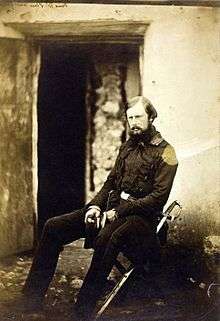 Prince Edward in 1855 | |||||
| Born | 11 October 1823 Bushy House, London | ||||
| Died | 16 November 1902 (aged 79) Portland Place, London | ||||
| Burial | |||||
| Spouse | |||||
| |||||
| House | Saxe-Weimar-Eisenach | ||||
| Father | Prince Bernhard of Saxe-Weimar-Eisenach | ||||
| Mother | Princess Ida of Saxe-Meiningen | ||||
| Religion | Lutheranism | ||||
| Occupation | Military | ||||
Career
Edward was born to Prince Bernhard of Saxe-Weimar-Eisenach and Princess Ida of Saxe-Meiningen at Bushy House, the home of his mother's sister Adelaide and her husband the future King William IV of the United Kingdom.[1]
After being naturalised as a British subject, Edward's military career began on 1 June 1841, when, having trained at the Royal Military College, Sandhurst, he joined the 67th (South Hampshire) Regiment of Foot as an ensign.[2] He was promoted to ensign in the Grenadier Guards and lieutenant in the Army on 8 June 1841 and lieutenant in his regiment and captain in the Army on 19 May 1846[3] before becoming adjutant of his battalion in November 1850.[4]
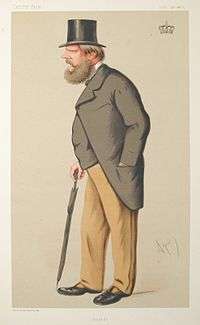
Edward was promoted to brevet major in the Grenadier Guards on 20 June 1854.[5] He served in the Crimean War and fought at the Battle of Alma in September 1854 and the Siege of Sevastopol in October 1854, where he was slightly injured.[6] He fought on at the Battle of Balaclava in October 1854 and the Battle of Inkerman in November 1854.[7] He was promoted to the brevet lieutenant-colonel "for distinguished Service in the Field" during the war on 12 December 1854.[8]
Edward was appointed an aide-de-camp to the Queen and received his colonelcy in the Grenadier Guards on 5 October 1855.[9] Granted the style of Royal Highness (to both Edward and his wife) in 1866, he was promoted to major-general on 6 March 1868.[10][11] He was appointed Major General commanding the Brigade of Guards and General Officer Commanding the Home District in 1870 and, having been promoted to lieutenant general on 6 July 1877,[12] he became General Officer Commanding Southern District in October 1878.[7] Promoted to full general on 4 November 1879,[13] he went on to be Commander-in-Chief, Ireland and a member of the Irish Privy Council in October 1885[14] before retiring in October 1890.[15]
In retirement Edward was a commissioner of the Patriotic Fund.[16] He also became colonel of the 10th Regiment of Foot[17] and then colonel of the 1st Regiment of Life Guards.[18] He was promoted to field marshal on 22 June 1897[19] following which there was adverse comment in The Times that his career had included no great military achievements.[7]
Prince and Princess Edward had for several years a summer residence at North Berwick, and in October 1902 the Prince was honoured with the Freedom of the Royal burgh of North Berwick, a week after he had hosted King Edward VII as his guest there for a couple of days.[20]
Edward died on 16 November 1902 at Portland Place in London and was buried in Chichester Cathedral,[21] in the crypt of his wife's family, the dukes of Richmond and Lennox.[7]
Family
On 27 November 1851 Edward married, morganatically, Lady Augusta Katherine Gordon-Lennox,[2] (a daughter of Charles Gordon-Lennox, 5th Duke of Richmond), who was created Countess of Dornburg by the Grand Duke of Saxe-Weimar the day before the wedding. The Court Circular shows that she was usually known by that title until early 1886, when the Circular began to consistently refer to her by her husband's title, i.e. "HSH Princess Edward of Saxe-Weimar".[22] They had no children.[7]
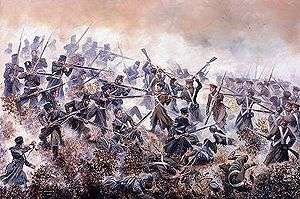
Honours
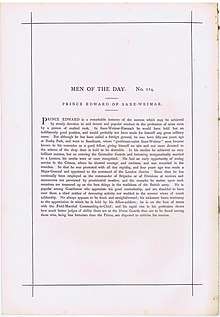
Edward received the following honours:[23]
.svg.png)
.svg.png)
.svg.png)
.svg.png)
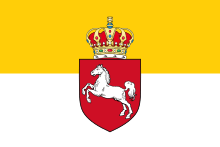

- Crimea Medal, 1854
- Companion of the Bath (military), 24 January 1857;[27] Knight Commander, 24 May 1881;[28] Knight Grand Cross, 21 June 1887[29]
- Knight of St. Patrick, 18 December 1890[30]
- Knight Grand Cross of the Royal Victorian Order, 8 March 1901[31]
.svg.png)
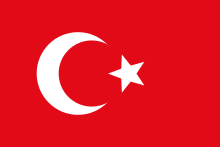
- Crimean War Medal, 1856
- Order of the Medjidie, 3rd Class, 2 March 1858[33]

.svg.png)


- Grand Cross of the Netherlands Lion
- Grand Cross of the Military William Order, 7 April 1858[34]

References
- The Times (14 October 1823): 3.
- Heathcote, p. 114
- "No. 20605". The London Gazette. 19 May 1846. p. 1835.
- "No. 21156". The London Gazette. 22 November 1850. p. 3096.
- "No. 21564". The London Gazette. 22 June 1854. p. 1937.
- "No. 21619". The London Gazette. 7 November 1854. p. 3353.
- Heathcote, p. 115
- "No. 21640". The London Gazette. 12 December 1854. p. 4052.
- "No. 21793". The London Gazette. 5 October 1855. p. 3683.
- "No. 23484". The London Gazette. 2 April 1869. p. 2053.
- "No. 23627". The London Gazette. 24 June 1870. p. 3109.
- "No. 24503". The London Gazette. 14 September 1877. p. 5235.
- "No. 24789". The London Gazette. 5 December 1879. p. 7216.
- "No. 25512". The London Gazette. 18 September 1885. p. 4388.
- "No. 26097". The London Gazette. 14 October 1890. p. 5454.
- "No. 26078". The London Gazette. 12 August 1890. p. 4377.
- "No. 24648". The London Gazette. 26 November 1878. p. 6495.
- "No. 25880". The London Gazette. 4 December 1888. p. 6940.
- "No. 26867". The London Gazette. 25 June 1897. p. 3570.
- "Prince Edward of Saxe-Weimar at North Berwick". The Times (36909). London. 27 October 1902. p. 4.
- "Funeral of Prince Edward of Saxe-Weimar", The Times (20 November 1902): 12.
- "Saxe-Weimar' H.S.H. Princess Edward". Historic Autographs. Retrieved 26 October 2013.
- "Genealogie des Großherzoglichen Hauses", Staatshandbuch für das Großherzogtum Sachsen / Sachsen-Weimar-Eisenach (in German), Weimar: Böhlau, 1900, pp. 8–9, retrieved 5 April 2020
- "Großherzoglich Hausorden der Wachsamkeit oder vom Weißen Falken", Staatshandbuch für das Großherzogtum Sachsen / Sachsen-Weimar-Eisenach (in German), Weimar: Böhlau, 1851, p. 7, retrieved 5 April 2020
- "Herzoglich Sachsen-Ernestinischer Hausorden", Adreß-Handbuch des Herzogthums Sachsen-Coburg und Gotha (in German), Coburg and Gotha, 1843, p. 7, retrieved 5 April 2020
- Staat Hannover (1860). Hof- und Staatshandbuch für das Königreich Hannover: 1860. Berenberg. p. 71.
- "No. 21962". The London Gazette. 27 January 1857. p. 277.
- "No. 24976". The London Gazette. 24 May 1881. p. 2673.
- "No. 25716". The London Gazette. 28 June 1887. p. 3497.
- Shaw, p. 105
- "No. 27292". The London Gazette. 8 March 1901. p. 1647.
- "No. 21909". The London Gazette. 4 August 1856. p. 2701.
- "No. 22107". The London Gazette. 2 March 1858. p. 1252.
- "Militaire Willems-Orde: Saxen-Weimar-Eisenach, W.A.E. hertog van" [Military William Order: Saxe-Weimar-Eisenach, W.A.E. Duke of]. Ministerie van Defensie (in Dutch). 7 April 1858. Retrieved 5 April 2020.
- "Königlicher Orden: Orden der Württembergischen Krone", Hof und Staatshandbuch des Königreichs Württemberg (in German), Stuttgart: Druck von W. Kohlhammer, 1896, p. 28, retrieved 5 April 2020
Sources
- Heathcote, Tony (1999). The British Field Marshals 1736–1997. Leo Cooper. ISBN 0-85052-696-5.
- Shaw, Willam (2012). The Knights of England: a Complete Record from the Earliest Time to the Present Day. Forgotten Books. ISBN 9780806304434.
External links
| Wikimedia Commons has media related to Prince Edward of Saxe-Weimar-Eisenach. |
| Military offices | ||
|---|---|---|
| Preceded by Sir Frederick Hamilton (as Major-General Commanding the Brigade of Guards) |
GOC Home District 1870–1876 |
Succeeded by Sir Frederick Stephenson |
| Preceded by Sir John Garvock |
GOC Southern District 1878–1884 |
Succeeded by Sir George Willis |
| Preceded by Sir Thomas Montagu Steele |
Commander-in-Chief, Ireland 1885–1890 |
Succeeded by The Viscount Wolseley |
| Preceded by Sir John Garvock |
Colonel of the 10th (North Lincoln) Regiment of Foot 1878–1888 |
Succeeded by Sir Henry Errington Longden |
| Preceded by The Earl of Lucan |
Colonel of the 1st Regiment of Life Guards 1888–1902 |
Succeeded by The Lord de Ros |
| New title | Colonel-in-Chief of the Lincolnshire Regiment 1888–1902 |
None appointed |